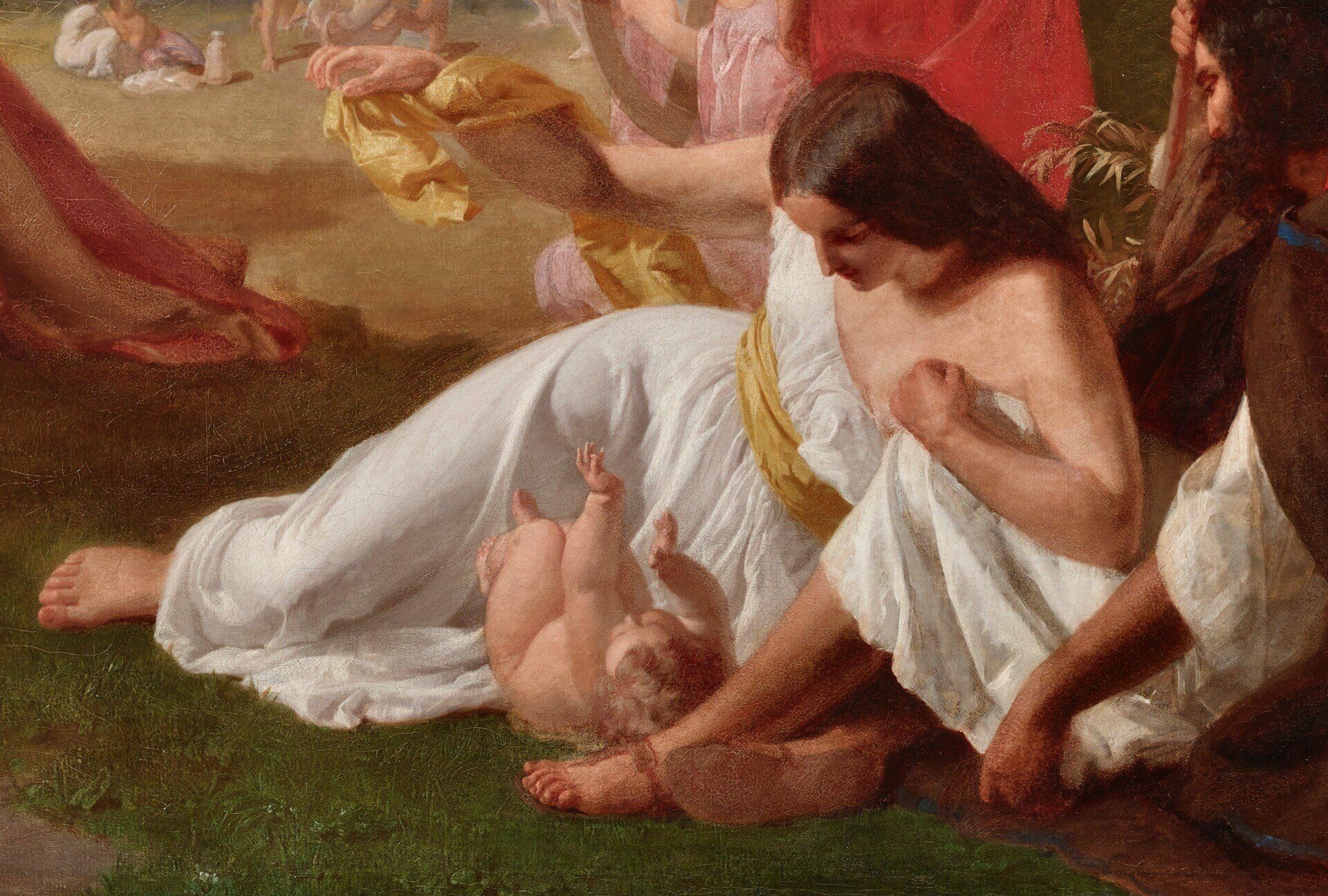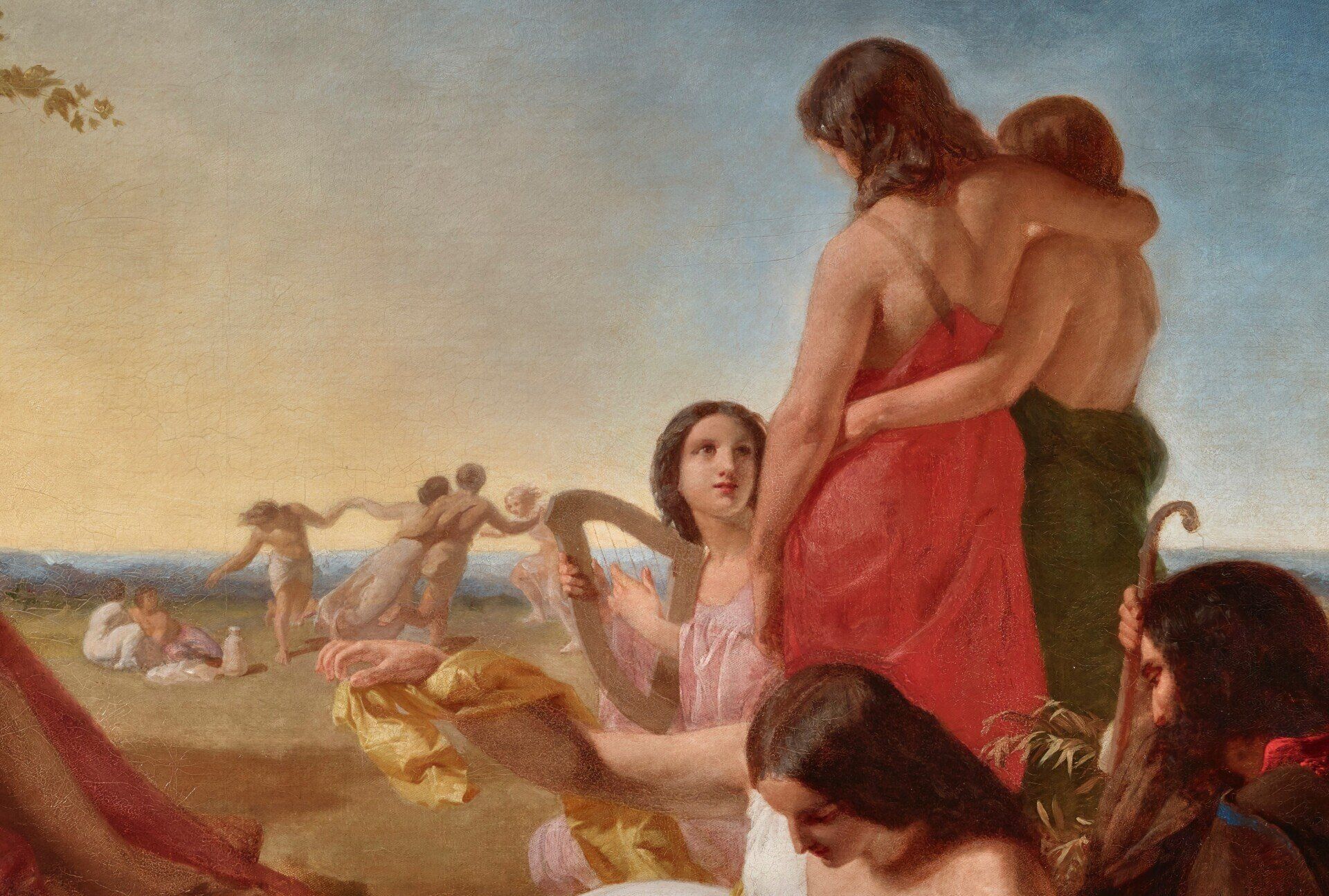PROVENANCE
- Private collection, Mansion for several generations and until 2017
BIBLIOGRAPHY
- Unpublished
THE ARTIST
Born in 1814 in Hamburg, Germany, Henri Lehmann was the son of a miniaturist who encouraged him from an early age to take an interest in art and the natural sciences. At the age of 16, he entered the studio of a copper engraver, then that of the German painter Siegfried Bendixen (1786-1864), who had studied under Jacques-Louis David (1748-1825). His teacher encouraged him to continue his apprenticeship in Paris, and in 1831 he entered the studio of Jean-Auguste Dominique Ingres (1780-1867), who would have a decisive influence on his art and career. The great master of Classicism passed on to him his love of Antiquity and the Italian Renaissance, and the need to study them closely in order to draw and paint accurately, which had a decisive influence on his art and career. Ingres, who considered him his best student, invited him to follow him to Rome, where he had been appointed director of the Villa Medici. Lehmann finally arrived in the Eternal City in 1838, at his own expense.
It was during this stay in Rome, which lasted around three years, that the young artist, who was melancholic and solitary by nature, became friends with Liszt and d'Agoult, who were on the run following the official announcement of their scandalous affair. Henri Lehmann was fascinated by these two characters and their pure passion, even though it was beginning to fade. He painted their portraits, which are now in the Carnavalet Museum—Liszt's was noticed at the 1839 Salon—and began a long correspondence with the Countess d'Agoult, whose hold on the young romantic's life and heart grew stronger before fading due to Marie's jealous outbursts.
A Rome aussi, il accompagne Théodore Chassériau (1819-1856), qu’il avait fréquenté dans l’atelier d’Ingres à Paris. Le jeune peintre, doté d’un incroyable talent précoce, est présenté comme un homme ambitieux, allant au-devant des projets du timide Lehmann trop crédule et fidèle en amitié pour se rebeller. Car, comme le rappelle Ingres à son élève, le succès vient surtout grâce aux relations. Pour faire carrière, Lehmann doit se résoudre à quitter son cocon italien pour rejoindre Paris. Il y obtient quelques belles commandes, dont une chapelle à Saint Merri et un plafond pour l’Hôtel de Ville (disparu dans l’incendie en 1871). Bien représenté à l’Exposition universelle de 1855, il reste pourtant loin derrière les maîtres du moment, Ingres et Eugène Delacroix (1798-1863).
In his 2015 book, Christophe Bigot[i], immerses readers in the life of an artist who rubbed shoulders with the greatest figures of his century: musicians Liszt and Chopin, writers Sainte-Beuve and Stendhal, and painters Chassériau and Delacroix. As the pages turn and the years pass, we also discover the difficulties and doubts of a promising young painter who resigns himself to remaining in the shadow of the geniuses of his time, foremost among them his master, Jean-Auguste-Dominique Ingres.
THE WORK
A unique and unprecedented iconography in Henri Lehmann's work, we invite viewers to see in it the microcosm of an entire life summarized in its major stages. Drawing on a concept inherited from Antiquity, undoubtedly enriched by a scholarship that escapes us here, Lehmann becomes the learned painter of the ages of man. Sketches,
Study of a Crouching Figure[ii]
(fig. 1) and
Study of a Kneeling Woman[iii]
(fig. 2), both signed
Henri Lehmann, similar to the old man in our composition and the woman beside him, are listed in Marie-Madeleine Aubrun's catalogue raisonné[iv], but cannot be associated with any known composition.
FIG.1. Henri LEHMANN
Study of a crouching figure
Signed, pencil, 11 x 8.5 inches
Current location unknown
FIG.2. Henri LEHMANN
Study of a kneeling woman
Signed, pencil, 8.3 x 11.4 inches
Current location unknown
In our composition, the homage to the master is twofold. A great admirer of the Italian Renaissance, whose painters he believed had achieved the sublime in pictorial art, Ingres drew heavily on it for inspiration in his own compositions. With his languid figure in the foreground, Lehmann reminds us that, like his master in his Jupiter et Antiope[v] — we note, moreover, a similarity between the two models with their right foot on the bank — he had seen Venice and the artists of the Cinquecento. Although he does not emphasize the sensuality of Giorgione and Titian's female figures, the connection is made in the pose. Even more so with this superimposition of horizontal space, Henri Lehmann invites our gaze to move from scene to scene and gain depth. While an overall interpretation is necessary to understand the painting, the symbolism keeps the viewer wondering and reminds us of certain Venetian works. Everything points to the work probably having been executed in Italy, as Lehmann joined Ingres in Rome in 1838.
Beyond this inspiration, Lehmann was undoubtedly influenced by the Neo-Greek movement, whose members followed in the footsteps of Ingres. Ingres himself was not immune to this movement and devoted himself to it for a time. The reference to Antiquity, which had been prevalent since the 18th century, thus evolved around the 1840s, a period that also corresponds to Lehmann's trip to Rome. Staged through compositions that had been rigorous until then, it became the setting for idylls and dreams, mixing seriousness with the scandalous. Lehmann was undoubtedly influenced by the Neo-Greek movement in his remarkable painting, in which the stages of life unfold. We are thus tempted to see a life that begins in the background, where two young people are invited to join the dancing circle, and then continues with the couple standing with their backs to us, whose physical bond foreshadows the scene in the foreground. Having reached adulthood, symbolized by the arrival of the child, the twilight of life finally resonates in the figures under the tree, illuminated by the soft light of the approaching evening.
The neoclassical frieze construction is broken up here by the two couples on the right, but the teaching of drawing as the basis of everything remains evident in Lehmann's figures with their fine lines and delicately flowing drapery. The palette, meanwhile, becomes warmer and more diverse. Thus, while many critics throughout his career judged Lehmann's colors to be cold, dry, and even archaic, here, on the contrary, the hues are warm and immerse us in the atmosphere of a summer evening in the Italian countryside. Without giving in to melancholy, life continues to resonate in the music and dance, whose echoes fill the most distant planes.
NOTES
[i] Christophe BIGOT, Les Premiers de leur siècle, Paris, Editions La Martinière, 2015.
[ii] Répertorié sous le n° D.897, page 202 du catalogue raisonné par Marie-Madeleine Aubrun.
[iii] Répertorié sous le n° D.295, page 85 du catalogue raisonné par Marie-Madeleine Aubrun.
[iv] Marie-Madeleine AUBRUN, Henri Lehmann, catalogue raisonné de l’œuvre, éditions Chiffoleau, 1984.
[v] Jean Auguste Dominique INGRES, Jupiter et Antiope, Signé et daté 1851, huile sur toile, 32,5 x 43,5 cm, Musée d’Orsay (inv. RF 2521).
PHOTOGRAPHS' DETAILS








